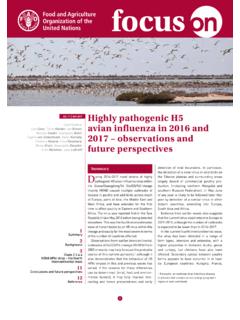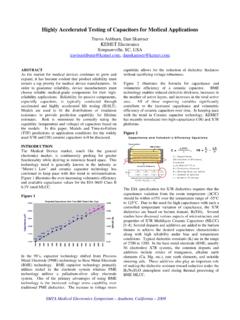Transcription of Highly active antiretroviral therapy (HAART) in adults ...
1 INT J TUBERC LUNG DIS 9(3):248 257 2005 The UnionHighly active antiretroviral therapy (HAART) in adults with tuberculosis: current status*A. Kwara, T. P. Flanigan, E. J. CarterSUMMARYD epartment of Medicine, Miriam Hospital/Brown Medical School, Providence, Rhode Island, USAThe overlapping epidemiology of human immunodefi-ciency virus (HIV) infection and tuberculosis (TB) andthe catastrophic consequences of the interactions betweenthe two epidemics have led to increased morbidity andmortality due to HIV-associated TB. While effective ther-apy is available for both conditions, there are majorchallenges in the concurrent treatment of HIV and TB co-infection.
2 This review examines the interactions betweenHIV and TB infections and reviews the current status ofhighly active antiretroviral therapy (HAART) in patientswith co-infection. Specific questions relating to optimaltiming of concurrent HAART, challenges to concurrentHAART, optimal regimens and future considerations WORDS:TB; HIV; interactions; HAARTTHE GLOBAL BURDEN of tuberculosis (TB) is enor-mous. In 2000, there were an estimated millionnew cases of TB, million of whom were The vast majority of individuals with TBlive in sub-Saharan Africa, the Western Pacific andSouth-East Asia,1 where 34 million (85%) of the esti-mated 40 million people with human immunodefi-ciency virus (HIV) infection also The overlap-ping epidemiology of HIV and TB infections has hadcatastrophic consequences.
3 In 2000, 11% of all newTB cases in adults occurred in persons infected withHIV, and 9% of all new TB cases were directly attrib-utable to In addition, an estimated 12% of million deaths from TB were attributed to HIVinfection and TB was the cause of 11% of all adult ac-quired immune-deficiency syndrome (AIDS) AND HIV INTERACTIONSThe interaction between HIV and TB infections is bi-directional. HIV infection increases the risk of bothprimary and reactivation TB,3 5 and this risk in-creases markedly with advancing HIV At thetime of TB diagnosis, most patients with co-infectionhave advanced HIV disease as defined by low CD4cell counts and high viral loads or World Health Or-ganization (WHO) Stage 3 and 4 ,6 This isnot surprising, as the control of Mycobacteriumtuberculosis infection is critically dependent on thepresence of CD41 T cells, CD81 T cells and the pro-duction of cytokines such as interferon-gamma (IFN-g)and tumor necrosis factor-alpha (TNF-a).
4 7,8 The de-velopment of active TB, on the other hand, is associ-ated with increases in HIV viral load locally and ,10 There is consequently an increased riskof progression to AIDS and 14 RATIONALE FOR CONCURRENT antiretroviral therapy IN TB PATIENTSThe case fatality rates of HIV-associated TB are high;the estimated aggregate case fatality rate of HIV-infectedTB is about 40%, and may be over 50% in many de-veloping ,15 TB case fatality rates appear tobe closely related to the prevalence of HIV infection,and HIV-related conditions may be the main cause forthe increased death rate associated with HIV and TB ,15 18 While deaths in the first month of TBtreatment may be due to TB.
5 Late deaths in co-infectedpersons are attributable to HIV disease 18 The current global TB control strategy using theWHO-recommended DOTS initiative alone is not suf-ficient to reduce TB morbidity and mortality in areasof high HIV While co-infected patientsoften receive quality TB treatment, the role of suchtreatment in slowing or reversing HIV disease pro-gression is doubtful. In the early 1990s, Martin et that TB therapy had a positive influence onthe CD4 lymphocyte count, with significant increasesin CD4 cell However, recent studies haveCorrespondence to: Dr Awewura Kwara, Division of Infectious Diseases, Miriam Hospital, Brown Medical School, 164 Summit Avenue, RISE Bldg, Providence, RI 02906, USA.
6 Tel: (11) 401-793-2463. Fax: (11) 401-793-4704. e-mail: submitted 22 March 2004. Final version accepted 1 July ARTICLE[A version in French of this article is available from the Editorial Office in Paris and from the Union website ]HAART in TB and HIV co-infection249demonstrated no significant increases in CD4 cellcounts or reduction in HIV-1 plasma loads duringtreatment of active TB in co-infected ,6,21 The failure of HIV plasma load to decrease in the ini-tial months of anti-tuberculosis therapy has been as-sociated with high systemic levels of TNF-a, whichhas been found to be sustained beyond the initial de-cline in mycobacterial These data suggest thateffective therapy to directly reduce HIV-1 plasmaload in co-infected persons may be necessary duringTB immunopathogenesis of HIV-associated TB7 10and modeling analyses22 suggest that by inhibitingHIV viral replication and allowing for CD41 T cell-related immune reconstitution, HAART will reduceboth the incidence of TB and mortality.
7 The use ofHAART in TB-endemic areas has been associatedwith more than 80% reduction in the incidence ofHIV-associated TB; the protective effect of HAARTwas seen at all stages of HIV disease, but was greatestin symptomatic patients and those with ,24 Several observational studies have alsofound that the use of concurrent HAART in co-infected patients during TB treatment is associatedwith reduced 26 Taken together, thesestudies suggest that HAART has promise in reduc-ing the high morbidity and mortality associatedwith TB-HIV SHOULD HAART BE STARTED?Concomitant HAART during TB therapy is compli-cated by high pill burden, overlapping drug toxicities,concerns about drug-drug interactions and paradoxi-cal immune reconstitution ,28 These con-cerns have often been used to argue for delayed or de-ferred initiation of HAART during TB 29In the clinical management of persons with active TBand HIV co-infection, there is consensus among ex-perts that TB treatment should be started immedi-ately following TB diagnosis,28 but the timing ofantiretroviral therapy from the time of starting TBtreatment remains controversial.
8 There are currentlyno published prospective controlled studies that haveexamined the optimal timing of HAART after initia-tion of TB therapy . Current treatment guidelines arebased mainly on retrospective observational studiesand expert ,29 The American Thoracic Soci-ety, the Centers for Disease Control and Prevention(CDC) and the Infectious Diseases Society of AmericaTB treatment guidelines suggest that delaying the ini-tiation of antiretroviral therapy until 4 8 weeks afterstarting anti-tuberculosis therapy will allow for betterevaluation of drug side effects, and reduce the severityof paradoxical reactions and adherence difficulties forthe This recommendation is based largely onthe high rates of treatment discontinuations due toadverse events observed in one study,26 and experts concerns about adherence when multiple medicationsare started at the same time.
9 Lack of HAART in thepatients with low CD4 cell counts is associated withincreased risk of subsequent AIDS-defining illness We have also observed an increased risk ofsubsequent AIDS-defining illness in co-infected patientswith CD4 cell counts ,100/ml in whom HAART Unlike the report by Dean et al.,26 therewere no discontinuations of TB or HIV therapyduring concurrent therapy in our patients, probablybecause of the use of largely non-protease inhibitor-based regimens in those patients who initiated con-current decision about when to initiate HAART in co-infected patients must balance the risk of HIV diseaseprogression with the potential risk of drug starting simultaneous concurrent therapyshould be avoided in co-infected patients, there is aneed for individualized assessment as to when to ini-tiate HAART after starting TB therapy .
10 A recent com-parative study found that virologic, immunologic andclinical responses to HAART of HIV-1-infected TBpatients treated concurrently with anti-tuberculosistherapy and HAART was similar to those of non-TBpatients,31 suggesting that we can not assume thatconcurrent HAART will be intolerable or lead to dif-ficulties with adherence. As antiretroviral therapybecome more compact and easy to manage, the riskof HIV disease progression must drive the decisionabout the timing of concurrent HAART in TB-HIVco-infected patients. Therefore, in patients with CD4cell counts ,100/ml or advanced AIDS, initiation ofconcurrent HAART must be considered as early aspossible.















